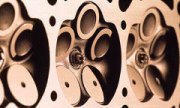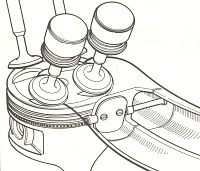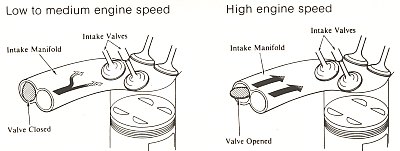轉載
[size=-1]History[size=-1]Multi-valve enginesstartedlife in 1912, adopted by a Peugeot GP racing car. It was briefly usedbythe pre-war Bentley and Bugatti. However, it was not applied toproductioncars until the 60s - Honda S600 was probably the earliest productionroad-going4-valve car. In the 70s, there were several more 4-valve carsintroduced,such as the Lotus Esprit (1976), Chevrolet Cosworth Vega (1975, enginemade by Cosworth), BMW M1 (1979) and Triumph Donomite Sprint. Thelatterintroduced the first single-cam 4-valve engine, using rocker arms todrivevalves.
[size=-1]In the early 80s,when Ferrarihad just adopted Quattrovalvole V8, Honda was introducing 3-valveenginesto its mainstream bread-and-butter models. In the mid-80s, both HondaandToyota made 4-valve engines standard in virtually all mainstreammodels.The Western car makers did that some 10 years later !
[size=-1]Theory
[size=-1]Improving breathingis oneof the keys for power enhancement. Unquestionably, in the 2-valve eravalvesused to be the bottleneck, hence the need for more valves.
[size=-1]3-valveengines
[size=-1]The earliest massproductionmulti-valve engines were 3-valves because of its simple construction -it needs only a single camshaft to drive both intake valves and theexhaustvalve of each cylinder. Today, there are still a few car cars usingthischeap but inefficient design, such as Fiat Palio and all Mercedes V6andV8 engines. Mercedes uses that because of emission rather than costreason.
[size=-1]4-valve engines
[size=-1]A typical 2-valveenginehas just 1/3 combustion chamber head area covered by the valves, but a4-valve head increases that to more than 50%, hence smoother andquickerbreathing. 4-valve design also benefit a clean and effectivecombustion,because the spark plug can be placed in the middle.
[size=-1]4 valves are betterto bedriven by twin-cam, one for intake valves and one for exhaust valves.Hondaand Mitsubishi models prefer to use sohc, driving the valves via rockerarms like the aforementioned Triumph. This could be a bit cheaper, butintroduce more friction and hurt high speed power. Therefore thesportiestHonda and Mitsubishi still use dohc.
[size=-1]5-valve engines
[size=-1]It is arguable thatwhether5 valves per cylinder helps raising engine efficiency. Audi claimed itdoes, but fail to provide evidence to support. In fact, its 5V enginesare no more powerful and torquey than its German rivals with 4 valvespercylinder.
 [size=-1]Originally,5-valve design doesn’t guarantee covering more head area than 4-valver.Nevertheless, if the head of combustion chamber is in irregular shapelikethe picture shown, the valves may cover larger area. Ferrari F355 makeuse of this to enhance high-speed breathing. Is there any disadvantage?Yes, faster breathing also harm low-speed torque if no counter measureis taken. Therefore it is more suitable to sports cars. [size=-1]Originally,5-valve design doesn’t guarantee covering more head area than 4-valver.Nevertheless, if the head of combustion chamber is in irregular shapelikethe picture shown, the valves may cover larger area. Ferrari F355 makeuse of this to enhance high-speed breathing. Is there any disadvantage?Yes, faster breathing also harm low-speed torque if no counter measureis taken. Therefore it is more suitable to sports cars.
[size=-1]All existing 5-valveengineshave 3 intake valves and 2 exhaust valves per cylinder, still arrangedas cross-flow. The exhaust valves are larger, but in terms of totalareaintake valves are larger. In F355, by arranging the outer intake valvesopen 10° earlier than the center valve, it got the swirl needed forbetter air / fuel mixture, hence more efficient burning and cleaneremission.
[size=-1]The advantage of5-valveengine is still under questioned. Not only few car makers used it (VWgroup,Ferrari and the bankrupted Bugatti), but Formula One cars also nolongerfavour it. Even the Ferrari F1 cars which was once famous for 5V enginehas switched back to 4-valve design a few years ago.
[size=-1]Drawbackand Solution - e.g. Toyota T-VIS
[size=-1]Most early 4-valveengineswere not good at low-to-middle speed torque, simply because the largerintake area resulted in slower air flow. Especially at low speed, theslowair flow in the intake manifold led to imperfect mixing of fuel andair,hence knocking and reduced power and torque. Therefore 4-valve engineswere regarded as strong at top end but weak at the bottom end, untilthetechnology of variable intake manifold became popular recently. TheaforementionedChevrolet Cosworth Vega performed particularly weak at low speed.
[size=-1]In response to this,Toyotaintroduced T-VIS (Toyota Variable Intake System) in the mid-80s. T-VISaccelerated low speed air flow to the manifold. The theory was quitesimple:the intake manifold for each cylinder was split into two separatesub-manifoldwhich joint together near the intake valves. A butterfly valve wasaddedat one of the sub-manifold. At below 4,650 rpm the butterfly valvewouldbe closed so that raising the velocity of air in the manifold. As aresult,better mixing could be obtained at the manifold (excludingdirect-injectionengines, fuel injection always takes place in the manifold).
   [size=-1]However, for latermainstreamsedan engines, Toyota dropped this idea and adopted a small-diameterintakemanifold / port design. Many other car makers also went the same way,sacrificinga bit top end power to improve low speed flexibility. Today, theintroductionof variable intake manifold can solve this problem. |

